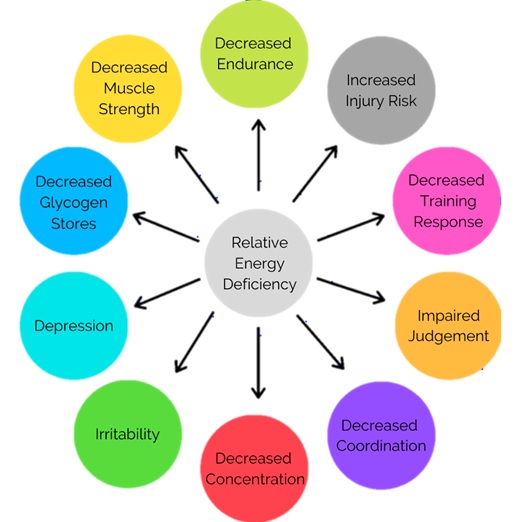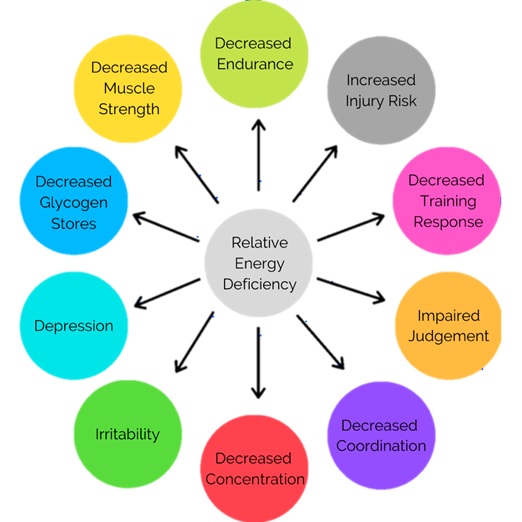
Most people don’t train anywhere near as hard as they should. The average person underestimates their own abilities and fails to reach their full potential. However there is a small subset of the population (typically athletes) who push themselves so hard that their health suffers as a result. Relative Energy Deficiency in Sports (RED-S) is an unfortunately common health condition. It occurs when an athlete doesn’t consume enough fuel to sustain their energy demands. Unfortunately most of us have never heard of RED-S. This lack of awareness is part of the reason why it’s so prevalent. If you’re unfamiliar with RED-S then read below. It’s important you know what it is so you can prevent it happening to you and your friends.
What Is RED-S?
RED-S is difficult to officially diagnose. Common symptoms include fatigue, low mood, frequent injuries, poor sleep and occasionally disrupted menstruation in women. You may experience some or all of these maladies. There are a whole range of potential symptoms and they often interact. Doctors will typically ask whether you have experienced frequent illness, injury or fatigue for at least three months. They may also test your hormones, screen you for risk factors and question your training and nutrition regiment. Only after they get the full picture of your current lifestyle will they be able to give you a RED-S diagnosis.

How Does It Come About?
RED-S is caused by an energy imbalance. It is the result of overtraining and undereating. Just like how you’d struggle to pay bills if you didn’t make any money. Your body isn’t getting enough food to pay its bills and as a result, you feel lethargic and malnourished. Underfueling can come about accidentally or on purpose. Some athletes intentionally restrict what they eat to maintain a low body fat. Others just aren’t aware of their nutritional requirements and unintentionally consume low calories. RED-S is dangerous because it can affect your long-term health. This concerning condition makes you more prone to injuries and disrupts multiple bodily symptoms. Not only do your hormones change but you also lose bone strength and feel totally knackered all the time. Your athletic performance will suffer greatly and you won’t even find pleasure in activities you once enjoyed.
History of RED-S
RED-S is a relatively recent term that was coined in 2014. Prior to this, the condition was referred to as the “female athlete triad” and it was thought to only affect women. Many years ago it was considered normal for a female athlete to lose her period. Studies from the early 2000s found that around 50% of dancers and female endurance athletes experienced menstrual abnormalities. Rather than being seen as problematic, athletes and coaches thought it was par for the course. Subsequent research has shown us that hormonal disruptions are not a natural consequence of competitive sports but actually a sign the athlete needs more fuel. Insufficient energy intake causes a number of different issues and men are just as susceptible as women. Female athlete triad was therefore a misnomer. The term RED-S far better encapsulates the broadness of this condition. Although it is good we know much more about RED-S these days, greater awareness is still needed.
Who’s At Risk?
As mentioned above, anyone can develop this condition (even non-athletes). RED-S does not discriminate based on age, gender or ability level. In saying this, some people are more at risk than others. Those who partake in endurance activities like long-distance running could be more susceptible because of the high energy demands. Gymnasts, jockeys, dancers and the like are also more at risk because their sports emphasise the importance of a lean physique. The psychology of the athlete significantly affects their chances of developing RED-S. Obviously those with a history of dieting or disordered eating are more susceptible because they have a tendency to restrict food intake. This doesn’t mean all competitive athletes who care about their physique are doomed to develop RED-S. It just means they need to be aware of the increased risk. All competitive athletes should familiarise themselves with RED-S in order to prevent it happening to them. If you train vigorously and experience some of these symptoms, talk to a professional and take a look at your current regime. You might not be giving yourself enough fuel or time to recover.
How Does One Treat RED-S?
The first port of call is to talk to a health professional. Your symptoms could be RED-S or they could be a range of other conditions that need to be ruled out first. Once you’ve established you’re suffering from a lack of energy, you need to rest and refuel. Increase your macronutrient intake and temporarily tone down the intensity of training. This will be difficult for a competitive athlete who is determined to take down their competition but it is a necessary part of treatment. Those with a lot of social support will find recovery easier than those going alone. It’s important to remember that your athletic performance will be better if you get sufficient fuel. Restricting nutrition will hinder and not help your training. Make sure to prioritise recovery and lean on your social support network. Talking about it with a friend and getting expert advice from trusted professionals makes a huge difference. Don’t be afraid to reach out and ask for help. Early diagnosis is key to preventing long term health issues.
Conclusion
Although awareness of RED-S is growing, more needs to be done. Most people aren’t sufficiently informed about the symptoms, prevalence and treatment of this condition. In order to solve the issue, we need more education. You can’t fix a problem you don’t know anything about. RED-S can have long-term health implications if not treated. Coaches, athletes and everyday people need to spread the word in order to reduce stigma and increase recognition. The more we know about RED-S, the less likely we are to suffer from it. Now that you have read this article, go tell a friend what you have learned. It might be the most important thing they hear today.
Written by Lauren Carruthers.
